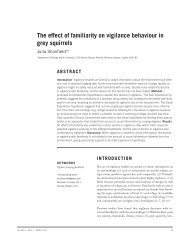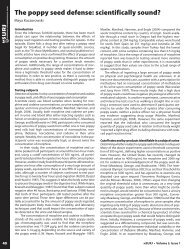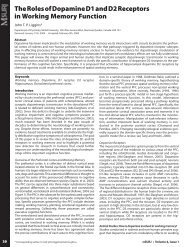the entire issue - McGill Science Undergraduate Research Journal ...
the entire issue - McGill Science Undergraduate Research Journal ...
the entire issue - McGill Science Undergraduate Research Journal ...
You also want an ePaper? Increase the reach of your titles
YUMPU automatically turns print PDFs into web optimized ePapers that Google loves.
Operational transformation in cooperative software systems<br />
1.<br />
IP1: Given a state S, and sequence of operations O ○ O:<br />
•<br />
j = <strong>the</strong> site that requested <strong>the</strong> operation<br />
S ○ O ○ O = S<br />
•<br />
s = <strong>the</strong> vector timestamp for <strong>the</strong> requested site<br />
2.<br />
IP2: Given any operation O, and a pair of operations O x<br />
and O x<br />
:<br />
•<br />
o = <strong>the</strong> operation to be performed<br />
3.<br />
IT(IT(O, O x<br />
), O x<br />
) = IT(O, I) = 0<br />
IP3: Given a state S, and two operations O a<br />
and O b<br />
:<br />
If: O′ a<br />
= IT(O ,<br />
O b<br />
), and<br />
O′ b<br />
= IT(O b<br />
, O a<br />
), and<br />
O a<br />
′ = IT(O a<br />
, O’ b<br />
)<br />
Then: O a<br />
′= O′ a<br />
Or: IT(O a<br />
, O′ b<br />
) = IT(O a<br />
, O b<br />
)<br />
• p = <strong>the</strong> priority of <strong>the</strong> operation<br />
Then, for <strong>the</strong> three activities (generation, reception, execution),<br />
dOPT performs <strong>the</strong> following:<br />
Algorithm 2 - Generate Operations<br />
receive operation O from <strong>the</strong> user<br />
calculate <strong>the</strong> priority p of O<br />
Control (integration) algorithms<br />
The OT control algorithm is <strong>the</strong> main high-level algorithm governing<br />
<strong>the</strong> collaboration functions that are available to <strong>the</strong> system. This<br />
algorithm controls <strong>the</strong> time/space complexity of <strong>the</strong> system, handles<br />
ordering of <strong>the</strong> operations by how timestamps are applied, and processes<br />
<strong>the</strong> incoming operations into <strong>the</strong> modified transformed operations<br />
(10, 12).<br />
Most OT systems, by design, are peer-to-peer distributed systems,<br />
but modifying <strong>the</strong> control algorithm can also determine whe<strong>the</strong>r <strong>the</strong><br />
system can also be centralized, which is important when adapting an<br />
OT system over <strong>the</strong> HTTP protocol.<br />
Comparison of control algorithms<br />
We now compare several implementations of OT control algorithms,<br />
from ones that are historically relevant in literature to modern day<br />
OT control algorithms that are used over HTTP.<br />
dOPT (GROVE)<br />
dOPT, used in <strong>the</strong> GROVE groupware outline editor program, is one of<br />
<strong>the</strong> earliest concurrency control algorithms for operational transformation<br />
(1). It uses a transformation matrix to handle conflict resolution,<br />
where for m operations, <strong>the</strong>re is an m x m matrix of <strong>the</strong> inclusive<br />
transformation resultant functions, for each pair of operations.<br />
Timestamps for each client are handled by a vector timestamp, where<br />
a state vector s i<br />
for a client C i<br />
will have at position j, <strong>the</strong> number of<br />
operations known to have been executed by client C j<br />
.<br />
A request queue, Q i<br />
, is used to queue up <strong>the</strong> requests that have been<br />
generated or received, and are waiting to be executed. Requests are<br />
handled in <strong>the</strong> form where:<br />
append request < i, s, o, p > to Q i<br />
multicast < i, s, o, p > to <strong>the</strong> o<strong>the</strong>r clients<br />
Algorithm 3 - Receive Operations<br />
receive < j, s, o, p > from <strong>the</strong> network<br />
append request < j, s, o, p > to Q i<br />
Algorithm 4 - Execute Operations<br />
for each request in Q i<br />
where s j<br />
≤ s i<br />
do<br />
remove request < j , s j<br />
, o j<br />
, p j<br />
> from Q i<br />
if (s j<br />
< s i<br />
) <strong>the</strong>n<br />
< k , s k<br />
, o k<br />
, p k<br />
> = most recent log entry<br />
where s k<br />
≤ s j<br />
(or ∅ o<strong>the</strong>rwise)<br />
while < k , s k<br />
, o k<br />
, p k<br />
> ≠ ∅; and o j<br />
≠ ∅; do<br />
if part k of s j<br />
is ≤ part k of s k<br />
<strong>the</strong>n<br />
o j<br />
= transform(o j<br />
, o k<br />
, p j<br />
, p k<br />
)<br />
end if<br />
< k , s k<br />
, o k<br />
, p k<br />
> = next log entry<br />
(or ∅ o<strong>the</strong>rwise)<br />
end while<br />
end if<br />
end for<br />
perform operation o on i’s data model<br />
add request to history log<br />
increment j th component of s i<br />
by 1<br />
Although dOPT is simple and satisfies many of <strong>the</strong> correctness properties,<br />
a scenario was found where dOPT could not always ensure<br />
convergence, when remote concurrent requests with similar operations<br />
were transmitted from two different sites.<br />
Fur<strong>the</strong>r research later helped to solve <strong>the</strong> problem, by using different<br />
data structures for <strong>the</strong> timestamp and conflict resolution (as in<br />
<strong>the</strong> Jupiter algorithm), or by transforming <strong>the</strong> log entries <strong>the</strong>mselves<br />
whenever <strong>the</strong>y are used to transform an update.<br />
66<br />
<strong>McGill</strong> <strong>Science</strong> <strong>Undergraduate</strong> <strong>Research</strong> <strong>Journal</strong> - msurj.mcgill.ca









